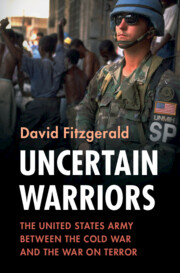Book contents
- Uncertain Warriors
- Military, War, and Society in Modern American History
- Uncertain Warriors
- Copyright page
- Dedication
- Contents
- Figures
- Acknowledgements
- Introduction
- 1 The Post-Vietnam Recovery, Operation Desert Storm and the Veneration of the Volunteer Soldier
- 2 Gender, Sexuality and the Profession of Arms
- 3 Warriors Who Don’t Fight
- 4 Downsizing, Recruiting and Debates over Military Service
- 5 Technological Transformation and the American Soldier
- 6 The Warrior Ethos
- Epilogue
- Index
4 - Downsizing, Recruiting and Debates over Military Service
Published online by Cambridge University Press: 19 October 2023
- Uncertain Warriors
- Military, War, and Society in Modern American History
- Uncertain Warriors
- Copyright page
- Dedication
- Contents
- Figures
- Acknowledgements
- Introduction
- 1 The Post-Vietnam Recovery, Operation Desert Storm and the Veneration of the Volunteer Soldier
- 2 Gender, Sexuality and the Profession of Arms
- 3 Warriors Who Don’t Fight
- 4 Downsizing, Recruiting and Debates over Military Service
- 5 Technological Transformation and the American Soldier
- 6 The Warrior Ethos
- Epilogue
- Index
Summary
Even as the Army increased its commitment to peacekeeping, its overall strength declined, as defence budgets dropped from their Cold War heights. This drawdown saw the Army turn inwards as it managed the shift from a forward-deployed overseas force to a smaller one primarily based in the continental United States. As the Army’s numbers fell and the overseas missions it deployed on increased, soldiers and their families suffered from the increase in operational tempo and the Army struggled to retain personnel. Later in the decade, the Army faced a severe recruiting shortfall amid a booming economy, as it missed its enlistment targets in 1998 and 1999. This shortfall, which coincided with an increasing reliance on the National Guard and Army Reserve for overseas deployments, as well as internal deliberations over the changing role of the Army, prompted renewed concerns about the health of the All-Volunteer Force. Tensions between the twin ideals of the ‘citizen soldier’ and the ‘profession of arms’ were heightened after the end of the Cold War, as the Army’s leadership struggled to rethink the nature of military service while managing a large-scale drawdown from their 1980s peak.
Keywords
- Type
- Chapter
- Information
- Uncertain WarriorsThe United States Army between the Cold War and the War on Terror, pp. 139 - 178Publisher: Cambridge University PressPrint publication year: 2023



